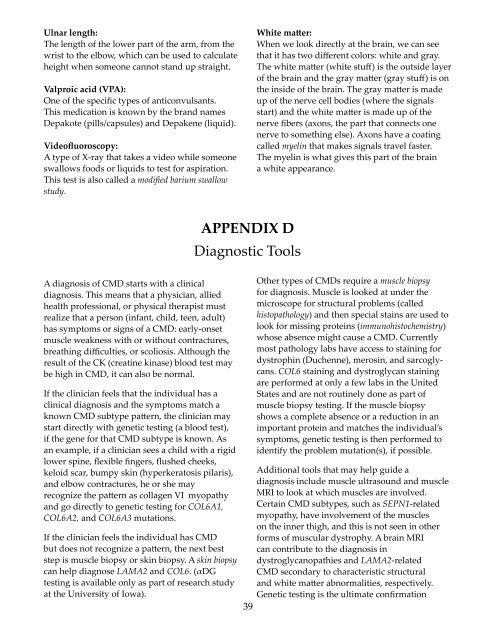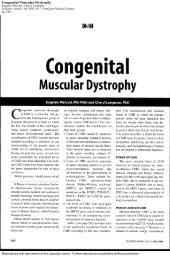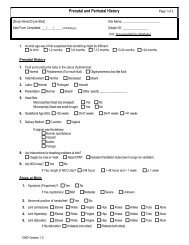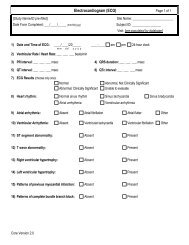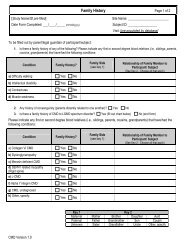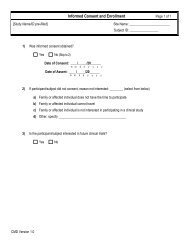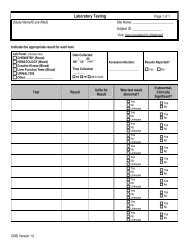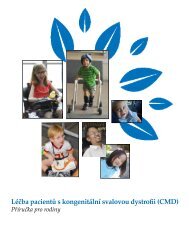The Management of Congenital Muscular Dystrophy ... - Cure CMD
The Management of Congenital Muscular Dystrophy ... - Cure CMD
The Management of Congenital Muscular Dystrophy ... - Cure CMD
Create successful ePaper yourself
Turn your PDF publications into a flip-book with our unique Google optimized e-Paper software.
Ulnar length:<strong>The</strong> length <strong>of</strong> the lower part <strong>of</strong> the arm, from thewrist to the elbow, which can be used to calculateheight when someone cannot stand up straight.Valproic acid (VPA):One <strong>of</strong> the specific types <strong>of</strong> anticonvulsants.This medication is known by the brand namesDepakote (pills/capsules) and Depakene (liquid).Vide<strong>of</strong>luoroscopy:A type <strong>of</strong> X-ray that takes a video while someoneswallows foods or liquids to test for aspiration.This test is also called a modified barium swallowstudy.White matter:When we look directly at the brain, we can seethat it has two different colors: white and gray.<strong>The</strong> white matter (white stuff) is the outside layer<strong>of</strong> the brain and the gray matter (gray stuff) is onthe inside <strong>of</strong> the brain. <strong>The</strong> gray matter is madeup <strong>of</strong> the nerve cell bodies (where the signalsstart) and the white matter is made up <strong>of</strong> thenerve fibers (axons, the part that connects onenerve to something else). Axons have a coatingcalled myelin that makes signals travel faster.<strong>The</strong> myelin is what gives this part <strong>of</strong> the braina white appearance.A diagnosis <strong>of</strong> <strong>CMD</strong> starts with a clinicaldiagnosis. This means that a physician, alliedhealth pr<strong>of</strong>essional, or physical therapist mustrealize that a person (infant, child, teen, adult)has symptoms or signs <strong>of</strong> a <strong>CMD</strong>: early-onsetmuscle weakness with or without contractures,breathing difficulties, or scoliosis. Although theresult <strong>of</strong> the CK (creatine kinase) blood test maybe high in <strong>CMD</strong>, it can also be normal.If the clinician feels that the individual has aclinical diagnosis and the symptoms match aknown <strong>CMD</strong> subtype pattern, the clinician maystart directly with genetic testing (a blood test),if the gene for that <strong>CMD</strong> subtype is known. Asan example, if a clinician sees a child with a rigidlower spine, flexible fingers, flushed cheeks,keloid scar, bumpy skin (hyperkeratosis pilaris),and elbow contractures, he or she mayrecognize the pattern as collagen VI myopathyand go directly to genetic testing for COL6A1,COL6A2, and COL6A3 mutations.If the clinician feels the individual has <strong>CMD</strong>but does not recognize a pattern, the next beststep is muscle biopsy or skin biopsy. A skin biopsycan help diagnose LAMA2 and COL6. (αDGtesting is available only as part <strong>of</strong> research studyat the University <strong>of</strong> Iowa).APPENDIX DDiagnostic Tools39Other types <strong>of</strong> <strong>CMD</strong>s require a muscle biopsyfor diagnosis. Muscle is looked at under themicroscope for structural problems (calledhistopathology) and then special stains are used tolook for missing proteins (immunohistochemistry)whose absence might cause a <strong>CMD</strong>. Currentlymost pathology labs have access to staining fordystrophin (Duchenne), merosin, and sarcoglycans.COL6 staining and dystroglycan stainingare performed at only a few labs in the UnitedStates and are not routinely done as part <strong>of</strong>muscle biopsy testing. If the muscle biopsyshows a complete absence or a reduction in animportant protein and matches the individual’ssymptoms, genetic testing is then performed toidentify the problem mutation(s), if possible.Additional tools that may help guide adiagnosis include muscle ultrasound and muscleMRI to look at which muscles are involved.Certain <strong>CMD</strong> subtypes, such as SEPN1-relatedmyopathy, have involvement <strong>of</strong> the muscleson the inner thigh, and this is not seen in otherforms <strong>of</strong> muscular dystrophy. A brain MRIcan contribute to the diagnosis indystroglycanopathies and LAMA2-related<strong>CMD</strong> secondary to characteristic structuraland white matter abnormalities, respectively.Genetic testing is the ultimate confirmation


